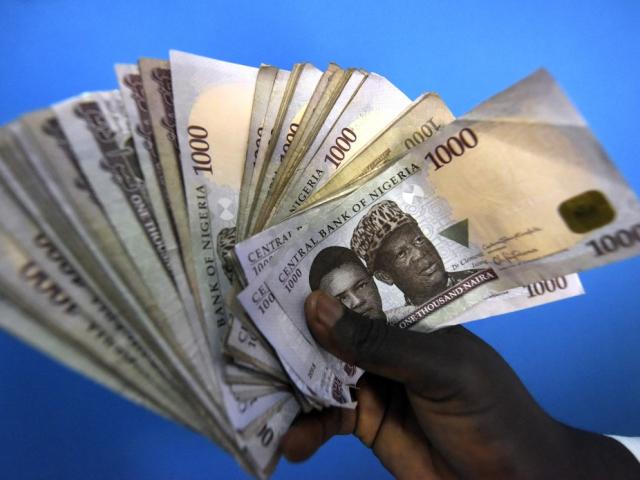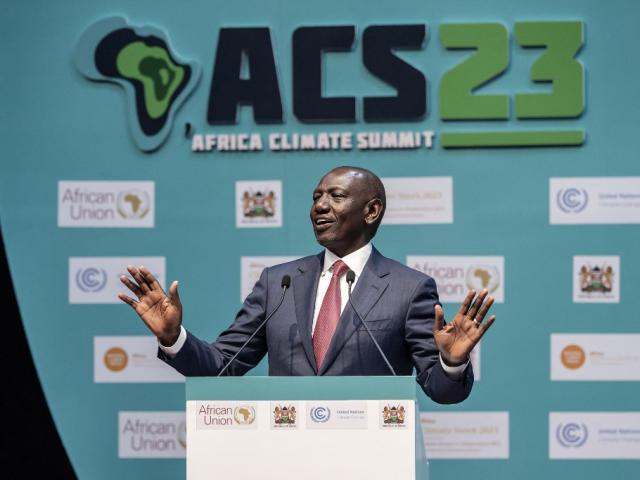-
The US is not Kenya’s biggest trading partner and Kenya doesn’t export US$890 million worth of goods to the US each year. But the ambassador was right about the value of goods going in the other direction, which is about $600 million.
-
Whitman was correct that Africa has the youngest median age, making it the “youngest” continent, with 60% of Africans aged 25 years or younger.
-
She was off about the percentage of electricity generated from renewable sources in Kenya, with the oft-repeated but incorrect figure of 93%. Closer to 87% comes from hydro, wind, geothermal and solar.
Kenyan president William Ruto has been courting US businesses to invest in his country.
In September 2023, he met with business leaders at the US-Kenya Business Roadshow in the city of San Francisco. The US ambassador to Kenya, Margaret 'Meg' Whitman, was present.
Whitman also championed Kenya, giving a presentation that positioned the East African country and the continent as an investment destination. The ambassador’s presentation has travelled well, with versions of it having been given to US business leaders visiting Kenya in March 2023, at a US-Kenya business roadshow in New York City in April 2023 and at Kenya’s devolution conference in Eldoret in August 2023.
“I love to muck around in the data,” Whitman said in San Francisco, noting that “the trade and investment data paint a much more dynamic business outlook for Africa”.
The ambassador made a number of claims to back up her pitch, including on energy, population and trade. (We are looking at further claims on mobile money).
But are her much-quoted numbers accurate? We checked.
“Kenya’s largest export market is the United States, just passed Uganda,” said Whitman in her presentation.
Later, she repeated the claim: “In 2022, the United States became Kenya’’s largest export market edging ahead of neighbouring Uganda.”
As evidence of the claim, Andrew Veveiros, a spokesperson for the embassy, sent us a link to a story published in the Business Daily, a Kenyan business newspaper, with the headline “US overtakes Uganda as top buyer of Kenyan goods”.
The article, published on 22 September 2022, cited data from the Kenya National Bureau of Statistics showing that Kenya exported goods worth KSh38.85 billion to the US and KSh36.19 billion to Uganda in the first half of the year.
“Statistics for 2023 are not out because the year is not complete,” Veveiros added.
An export market is a country or group of countries to which goods and services from another country are sold. Kenya exports goods such as clothing, nuts, titanium ore and coffee to the US.
Africa Check asked Simon Gaitho, a senior manager at the Kenya National Bureau of Statistics, where we could find data to verify this claim. He referred us to the bureau’s 2023 economic survey, the most recent available.
The data, which covers 2022, shows that Uganda remains Kenya’s largest export market with a total of KSh97.2 billion or US$824.6 million worth of goods and services exported there that year. Over the same period, Kenya’s exports to the US were KSh79.9 billion or $678.1 million. (Note: Conversions use the average 2022 exchange rate of KSh117.87 to the US dollar).
For more trend data, Gaitho said to check the quarterly balance of payments reports. These are a record of the money Kenya receives from and pays to foreign countries. The difference between receipts and payments represents a surplus or deficit.
The latest data shows that the US only overtook Uganda as Kenya's export market for one quarter in 2022 – between April and June.
But since then, Uganda has regained its position as the top export destination, with the latest data showing that it is responsible for almost double the value of Kenyan exports sent to the US.
Numbers disputing ambassador’s claims from various sources
If a period shorter than one year is used, the data still shows the same trend. Kenya’s total exports to the US between January and June 2023 were KSh32.2 billion ($244.4 million). In the same period, Kenya's exports to Uganda amounted to KSh62.9 billion or $477.2 million. (Note: The conversion rate here is KSh131.75 to the US dollar, the average for the half year.)
The United States is “Kenya's second-largest export market in 2022”, the World Trade Organization told Africa Check in an email. The WTO deals with the rules of trade between nations and has 160 members.
The organisation said the International Trade Centre’s statistical database was a reliable source of figures. The database has information up to 2022 which shows that Kenya's exports to the US were $679.3 million, against $822.9 million to Uganda.
The 2022 data would have been available to the embassy, as well as tentative data for the first half of 2023. Whichever way you look at it, Uganda is a bigger export market for Kenya.
We therefore rate this claim as incorrect.
In making this claim, Whitman spoke of the “vibrant bilateral trade” between the two countries.
Her supporting slide displayed the following text: “In 2022, Kenya exported $890 million in goods to the US …”
The latest data from Kenya’s statistics bureau shows that the country exported goods worth KSh79.9 billion, or $678.1 million, to the US in 2022. (This is a provisional figure using the average exchange rate of KSh117.87 to the dollar.)
The International Trade Centre (ITC) also recorded Kenya's exports to the US at $679.3 million in 2022. Whitman’s data is therefore off by at least $210 million.
However, the US department of commerce data shows that US imports from Kenya were $875 million – just $15 million less than the ambassador’s figure. The ITC data showed that the US imported $924 million worth of goods from Kenya – more than her figure.
The difference between the value of imports to the US and exports as recorded in Kenya can be explained by a number of factors, according to the United Nations statistics division. These include differences in reporting procedures and valuation, and the time lag between when goods leave Kenya and when they arrive in the US.
“Imports are generally reported on a cost, insurance and freight (CIF) basis, while exports are reported on a free on board (FOB) basis. For this reason, import values tend to be higher than export values,” the UN office said.
Free on board means that transport costs and insurance costs are not included. These are however included when reporting on a CIF basis.
Because Whitman specifically referenced Kenyan exports, we rate the claim as incorrect.
In addition to what Kenya sends, Whitman said “the US exported $600 million in goods to Kenya”. Her accompanying slide had the following text: “... the US exported around $600 million in goods to Kenya.”
Data from the US department of commerce shows that the country exported $604 million worth of goods to Kenya in 2022.
The International Trade Centre put the figure at $599.7 million in 2022.
US export figures as reported in the US and by the ITC are in line with Whitman's figure. We rate the claim as accurate.
For data to verify this claim, Africa Check contacted Dr Thomas Spoorenberg, the population affairs officer in the department of economic and social affairs of the United Nations Population Division.
He gave us a link to the latest official population estimates and projections from the World Population Prospects and pointed us to the median age.
This is the age at which half the population is older and half is younger. A lower median age usually indicates a younger population, while a higher median age indicates an older population.
The data shows that Africa's median age in 2023 will be 18.8 years, making it the youngest population in the world.
|
Median age across continents |
|
|
Continent |
Median |
|
Africa |
18.8 |
|
Asia |
31.9 |
|
Europe |
42.2 |
|
Latin America and the Caribbean |
31.0 |
|
North America |
38.4 |
|
Oceania |
32.7 |
Source: World Population Prospects
Spoorenberg said sub-Saharan Africa's youthful population was the result of higher birth rates.
“The youthful population of sub-Saharan Africa is the result of past and present higher fertility. The fertility transition [decline in birth rates] in sub-Saharan Africa started later, at higher fertility levels, and is slower compared to the experience of the other regions,” he told Africa Check by email.
Women in Africa had between three and six children, with the lowest average being in southern Africa, at three children, and the highest being in middle or central Africa.
“These fertility figures have implications for current and future population growth. Most of the future population growth will occur in the region,” said Spoorenberg.
For data on this claim, Spoorenberg, the UN demographer, directed us to the World Population Prospects 2022.
It showed that in 2021, the latest year for which data are available, some 829 million people in Africa were under the age of 25. The total population was 1.39 billion. (Editor’s note: A downloadable Excel file is available here.)
Similar data has been published in Our World in Data, a data portal based at the Oxford Martin Programme on Global Development at the University of Oxford in the UK.
Embed table:
This works out to 60% of Africa's population being between the ages of zero and 24. We rate this claim as correct.
Renewable energy is the energy produced from naturally replenishing sources. It produces far fewer emissions than burning fossil fuels. These sources include bioenergy, geothermal, wind, solar and hydroelectric power.
Whitman said Kenya generated 93% of its electricity from renewable sources. Whitman made the same claim in a presentation in March 2023, saying that more than 90% of Kenya’s grid electricity was generated from these sources.
According to the latest report from Kenya's Energy and Petroleum Regulatory Authority, a lower figure – 87.42% – of the energy generated in Kenya came from renewable sources. These were hydro (21.8%), wind (17.22%), geothermal (45.5%) and solar (2.9%).
Source: Energy and Petroleum Regulatory Authority
Whitman's claim is not backed up by the available data. We previously checked this claim when a South African commentator made it in July, quoting Whitman, and when the Kenyan president said it in August, and found the claim incorrect.
Tess Wandia also contributed to the writing of this report.
EDITOR'S NOTE: This report was updated on 31 October 2023 with the embassy's response on the source of its data.








Add new comment